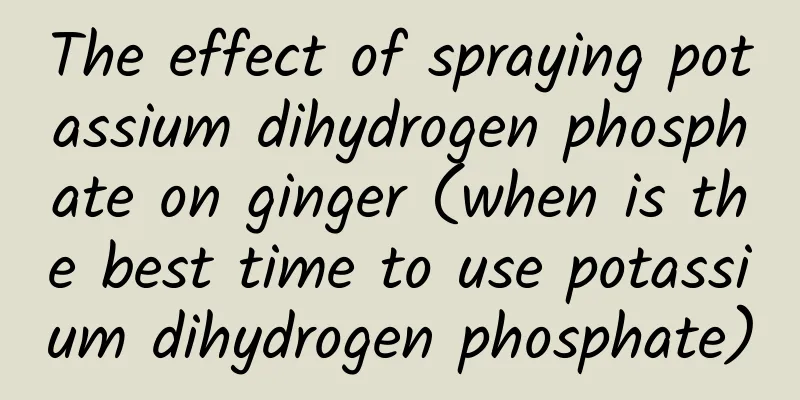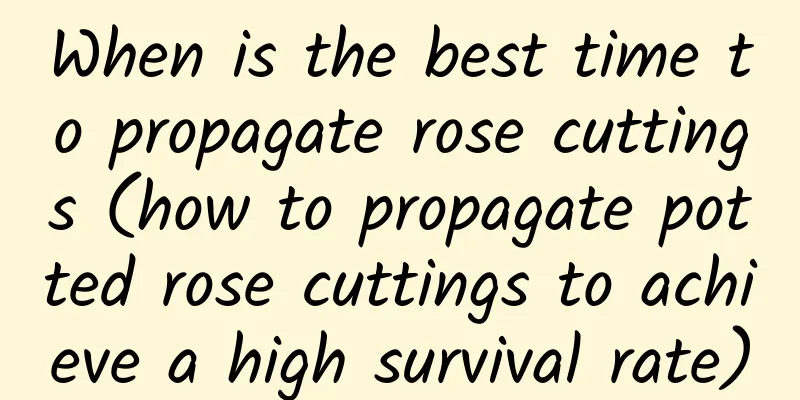The effect of spraying potassium dihydrogen phosphate on ginger (when is the best time to use potassium dihydrogen phosphate)

|
Ginger is a crop that requires a lot of fertilizer and rarely suffers from fertilizer damage. Due to its underdeveloped root system, it must be supplemented in stages to meet the nutrient needs of ginger growth. Generally, ginger fertilizer and water management is divided into three stages, namely, fertilizer for seedling promotion, fertilizer for seedling strengthening and fertilizer for ginger strengthening. 1. Seedling FertilizerSeedling-promoting fertilizer is the fertilizer applied after the ginger seedlings have all emerged. Its purpose is to promote the seedlings and make them grow vigorously. In this period, nitrogen fertilizer is mainly applied, which is generally applied with water. If you have sufficient base fertilizer, you can avoid or apply less topdressing this time. At this time, the ginger is still in the small greenhouse, and the seedlings require less fertilizer and a greater demand for nitrogen fertilizer. Under normal circumstances, only urea, ammonium sulfate, high-nitrogen water-soluble fertilizers, etc. are applied. Just add an appropriate amount of rooting products. Generally, potassium dihydrogen phosphate foliar fertilizer is not sprayed, but you can spray some boron fertilizer and zinc fertilizer in combination with the medication. 2. Fertilizer for strong seedlingsAfter ginger enters the three-branch period, the amount of fertilizer required increases, and the arch shed has been removed at this time, which is conducive to fertilization. At the same time, the temperature during this period is not too high, which is also conducive to the growth of ginger. During this period, the soil can be ditched and nitrogen, phosphorus, potassium compound fertilizers, organic fertilizers, etc. can be applied. Since the ginger seedlings are no longer protected by the arch film, diseases and pests will increase. During this period, you can add an appropriate amount of potassium dihydrogen phosphate in combination with spraying to make the leaves greener, thicker and wider, thereby improving photosynthetic efficiency. 3. Ginger and fatWhen ginger has more than 5 branches, it is the period of rapid expansion of underground ginger pieces and the fertilizer requirement increases. At this time, you can dig trenches and apply nitrogen, phosphorus, potassium compound fertilizers, organic fertilizers, etc. Since the soil will be heavily fertilized after topdressing during this period, it is no longer possible to dig trenches and apply fertilizers, and fertilizers can only be flushed with water and sprayed on the leaves. Therefore, if you want to spray potassium dihydrogen phosphate, the best time is in the middle and late stages of ginger growth, that is, after the major soiling. After the ginger is covered with soil, the temperature gradually drops and the ginger enters a vigorous growth stage. Both the number of branches and underground ginger pieces increase day by day. Therefore, on the basis of applying sufficient fertilizer to the soil, spray potassium dihydrogen phosphate, boron fertilizer, zinc fertilizer and other trace element fertilizers on the leaves to ensure that the ginger is well fed and the yield is increased. However, we should understand that potassium dihydrogen phosphate is only a binary compound fertilizer containing phosphorus and potassium. Although the content is high, the concentration we use when spraying it on the leaves is relatively low, mostly around 0.3%, and only 3 or 2 buckets of liquid fertilizer are sprayed per acre of land. Think about it, even if potassium dihydrogen phosphate is pure and has a 100% content, how much fertilizer can be sprayed on ginger with tens of thousands of branches? And how much effect can it have? Therefore, spraying potassium dihydrogen phosphate fertilizer on the leaves of any crop can only be used as an auxiliary fertilization method. It can only be sprayed 2-3 times in the middle and late stages of crop growth and development, with an interval of 8-10 days each time . When spraying potassium dihydrogen phosphate on ginger, it is best to do it in the morning and evening every day. Do not spray it under the scorching sun, and do not mix it with alkaline substances. Some people like to mix potassium dihydrogen phosphate and urea together and apply it with water, but I don’t recommend you to do so. First, phosphorus and potassium have very low mobility in the soil, and the utilization rate of fertilizers applied with water is very low. They basically stay on the soil surface, and too little nutrients reach the roots. Second, the price of potassium dihydrogen phosphate is relatively high, and applying it with water will greatly increase the planting cost. It is better to buy water-soluble fertilizer. 【 Summarize 】 Although potassium dihydrogen phosphate is a relatively good fertilizer and can promote photosynthesis, absorption, strong stalks, root growth, early maturity, lodging resistance, cold resistance, drought resistance, and disease and insect resistance, its main function is to promote flowering and fruiting. Therefore, whether it is ginger or other crops, when spraying potassium dihydrogen phosphate, it is best to spray it before and after the flowering period, in the middle and late stages of growth and development. Generally, spraying 2-3 times is sufficient . |
>>: When is the best time to plant soybeans (soybean planting time and harvest cycle)
Recommend
How to deal with rose seedlings after they become stiff in summer
1. Ventilation Due to the high temperature in sum...
How to plant red tassel flower seeds
Seed acquisition and storage The flowering period...
How often should you water your pineapple?
How often should you water your pineapple? Genera...
Can Syngonium be hydroponically cultivated? Is hydroponics better or soil cultivation better?
Can Syngonium be hydroponically cultivated? Syngo...
When to sow chrysanthemum seeds
1. Sowing time The best time to sow chrysanthemum...
What to do if the tips of Chunlan leaves dry up
Pests and diseases The main reason for the drying...
Avocado color, the difference between avocado oil and walnut oil
1. Color difference There is a clear difference b...
What flowers to give to female friends?
1. Pink Lily The flower language of lily is smoot...
How many years can Verbena be grown?
1. How many years can it be raised? Verbena is lo...
Time and method of changing soil for azalea
Time to change the soil for azalea It is necessar...
How to water the fern
Watering tips for fern The money fern is a plant ...
What flowers are suitable for growing in Hegang? What are the city flowers and trees?
1. Climate characteristics of Hegang Hegang has a...
What are the methods and precautions for raising meat?
Meat breeding method Succulents are also called f...
When does the Queen of Ruyi bloom?
Will this plant flower? Queen Ruyi is a foliage p...
How much leek yield per mu? How much profit can be made from planting leek per mu?
Leek yield per mu Leek is a vegetable that grows ...









